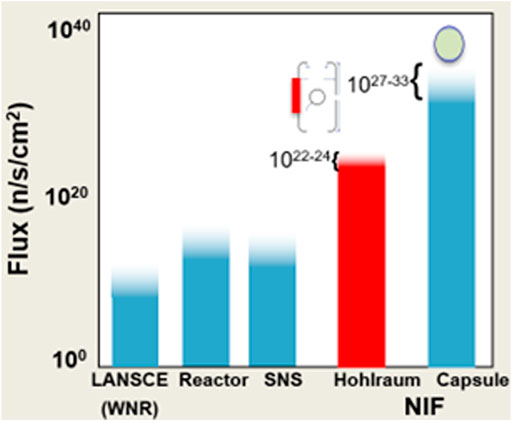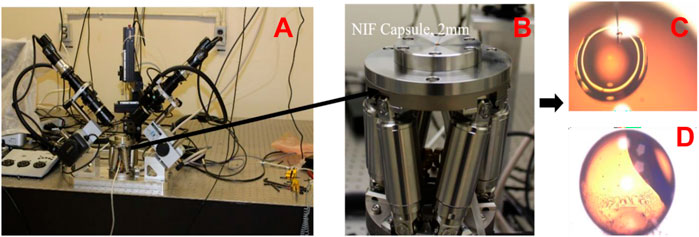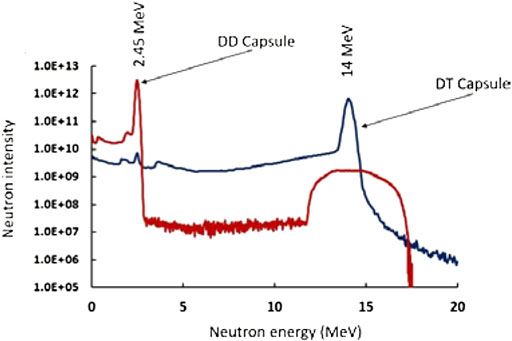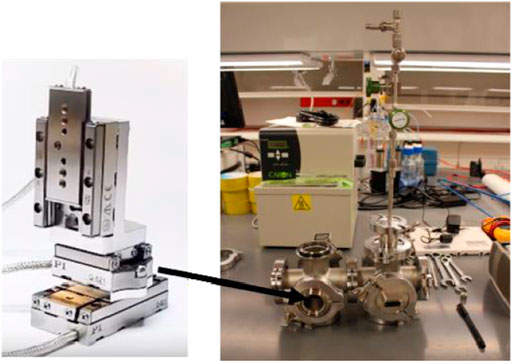- Lawrence Livermore National Laboratory, Nuclear and Chemical Sciences Division, Physical and Life Sciences Directorate, Livermore, CA, United States
The Nuclear and Radiochemistry Group at Lawrence Livermore National Laboratory (LLNL) has developed a suite of diagnostics and techniques that can be used for astrophysics experiments at the National Ignition Facility (NIF). Capabilities have been developed to add material to the outside of NIF hohlraum assemblies as well as to the interior of NIF target capsules or the fill gas. The ability to place very small amounts of material close to the NIF target enables activation with very large, short-pulse neutron fluxes. The Solid Radiochemistry Diagnostic can be used to collect solid debris from a NIF shot within 2 h of the execution of a shot, and this can be analyzed for radioactive signatures with or without post-shot chemical processing. The Radiochemical Analysis of Gaseous Samples diagnostic system can be used to collect gaseous products produced during a NIF shot. Capsule doping and radiochemical analysis capabilities at NIF will be discussed. The application of these techniques to astrophysical measurements will be discussed as well as some preliminary results.
Introduction
The National Ignition Facility at LLNL uses an indirect drive configuration of 192 laser beams with high energy (>MJ), ns-long pulses to heat the interior of a cylindrical hohlraum to extremely high temperatures (3.5 million K) [1–3]. This results in a flux of x-ray photons that ablates the surface of a 2-mm outer diameter (∼1800 µm inner diameter) spherical target at the center of the hohlraum (indirect drive). Target capsules can be manufactured out of plastic (CH), high density carbon (HDC, diamond), or beryllium. The interior of the target is filled with a mixture of deuterium-tritium (DT) either as a gas (in indirect drive exploding pusher capsules) or as an ice layer with a central, lower-density gaseous zone (ignition capsules). Ablation of the ignition capsule causes the remainder of the capsule and DT fuel to compress by a factor of 20–40, which heats the central hot spot to 10–100 million K (∼1–10 keV) with Gbar pressures. At peak compression, a part of the fuel undergoes the D (T,n) thermonuclear reaction, producing upwards of ∼1017 neutrons (14.1 MeV) in a time span of ∼100 ps [3]. For the exploding pusher capsules, well-characterized plasmas at even hotter temperatures (10–20 keV) and lower densities are possible with yields of 1012–14 neutrons [1]. The fusion burn phase of a NIF capsule create the most intense neutron flux in the world (Figure 1).

FIGURE 1. Neutron flux at various neutron sources, demonstrating the extremely high fluxes possible for material placed on the hohlraum or in the capsule at NIF. Capsule fluxes have a larger range due to both varying neutron yields as well as capsule compressions, whereas the hohlraum does not compress and has a range simply based on neutron yield differences.
It is also possible to fill a capsule with deuterium-deuterium (DD) only, which will result in a peak neutron energy at 2.45 MeV (Figure 2).
The extremely high neutron flux and short timescale of the neutron pulse in a NIF shot allows for nuclear reactions to be measured on radioactive species that would be impossible at traditional accelerator facilities. Limited real-world data exists for reactions on short-lived, excited nuclear states or multi-reaction pathways that are important to the high energy density (HED) plasma environment. In the absence of measured nuclear data, the models currently used to calculate these neutron-capture cross sections under stellar and thermonuclear reaction conditions have large uncertainties, on the order of 100–300% [4].
No other facilities exist with the ability to study, in stellar-like plasma conditions, charged particle- and neutron-induced nuclear reactions, which are integral to stellar nucleosynthesis and solar neutrino production. Decreasing reaction cross sections as a function of energy make measurements at the energy ranges that are found in the core of stars (<100 keV) inaccessible with accelerator-based experiments. Due to these very low reaction rates, it is exceedingly difficult to perform appropriate measurements as extremely long irradiation times would be required. Furthermore, an accelerator cannot create the plasma environment found within a stellar interior. While some neutron-induced and thermonuclear reaction rates of interest to stellar nucleosynthesis and big-bang nucleosynthesis have been studied at accelerators, these conditions are very different from those found in stars. In accelerator experiments, target nuclei are surrounded by bound electrons; in stars, electrons occupy mainly degenerate states. Therefore, results from accelerator experiments must be corrected for the differences in electron screening between the dense, stellar interior and beam-target experiments [5, 6].
Due to the convergence of conditions present in a NIF capsule, performing high-fidelity measurements of stellar reactions is possible as reaction rates are dramatically higher, and the temperature and density conditions are closer to those in a stellar interior. A NIF shot creates plasma conditions that are closer to those in stars; therefore, NIF-based experiments require less extrapolation from experimental parameters to determine actual stellar screening conditions [5]. The high compression of a NIF capsule dramatically increases the effective target areal density, and the electron-free cloud in the plasma contained within a NIF capsule is a unique condition that cannot be created at an accelerator and contains some aspects of a stellar interior. This unique environment makes NIF experiments excellent opportunities for resolving gaps in theoretical calculations of nuclear reactions in plasmas with real-world data. The Nuclear and Radiochemistry Group at LLNL has developed several techniques and diagnostics for measuring such nuclear reactions at NIF. By employing radiochemical techniques coupled with solid and gaseous debris collection systems, nuclear reaction measurements on very small quantities of radioactive material are now possible at NIF.
Radiochemistry capabilities
Solid debris collection
Several solid debris collectors have been developed to capture post shot debris containing the nuclear reaction products of interest. The Solid Radiochemistry Diagnostic (SRC) consists of 2-inch diameter, 0.5–1 mm thick metal discs (typically Ta, W or C but other materials are possible) that are contained in a cap, which is attached to the snout of a Diagnostic Insertion Module (DIM) with a quick release bracket (Figure 3A) [7]. A maximum of four SRC collectors can be fielded at three different DIM locations (0,0) (90,78) and (90,375). With the collectors positioned 50 cm from the Target Chamber Center (TCC), each of the SRC discs has a surface area that covers 4 × 10−4 of the 4π solid angle of the NIF chamber [7]. The Vast Area Detector for Experimental Radiochemistry (VADER, Figure 3B) is another solid debris collector that can be attached to a DIM 50 cm from TCC. This collector can field up to nine collectors simultaneously as either trapezoidal foils or standard SRC 2-inch discs mounted within a trapezoidal holder. The VADER collector covers roughly 1% of the 4π solid angle [8]. The final solid debris collector in use at NIF is the Large Area Solid Radiochemistry (LASR, Figure 3C) collector. LASR consists of a 20-cm diameter V or Ta foil and Al side foils with a 4π solid angle of ∼1% when it is fielded 50 cm from TCC. This collector may be installed on DIMs at (90,75) or (90,315) and it is possible to position the LASR collector closer to TCC, which increases its solid angle coverage to roughly 5% [9].

FIGURE 3. Solid radiochemical collection capabilities at NIF. The SRC (A) and VADER (B) are shown mounted on snout tubes that are subsequently mounted to DIMs; LASR (C) is attached directly to the end of the DIM snout. The percent solid angle of the NIF chamber subtended by the collector face is given for each collector.
For all solid debris collectors, the DIMs are retracted from the NIF chamber following a NIF shot, the collectors are disassembled from their housings, then delivered to the LLNL Nuclear Counting Facility (NCF) for gamma-ray spectroscopy. It is possible to have these samples arrive at the NCF within 2 h post-shot depending on the neutron yield. The collectors can be chemically leached or dissolved for further radiochemical processing, if needed, to isolate the reaction products of interest from the background activity produced via neutron activation of the collector materials, which can enable more accurate measurements [10].
Gaseous debris collection
The Radiochemical Analysis of Gaseous Samples (RAGS, Figure 4) diagnostic is used for the isolation and purification of gases produced in a NIF shot [11]. RAGS uses the NIF target chamber (TC) turbopumps to remove gas from the NIF chamber after a shot. The NIF TC cryopumps are closed just before the shot to prevent the loss of gases that would freeze on their 20 K stages. The gas is first sent through a filter cart that removes water vapor and particulates, as well as an reactive gases such as nitrogen and oxygen if necessary, and then to a gas collection cart where gases collect on a cryogenic cold head that can reach 44 K. Gases that do not freeze at 44 K are held in a tank at the end of the sampling train. The RAGS system has several advantages including high collection efficiency (∼90%) and the ability to release known amounts of stable or radioactive tracer gases into the TC on a shot to determine the RAGS fraction of gas recovered. Samples can be released into sample bottles for measurements with mass spectrometry or High Purity Germanium (HPGe) gamma-spectroscopy at the NCF [9]. There are also in situ HPGe and LaBr3 radiation detectors for measuring activity at various locations within the system. The RAGS system can also be used to collect gases other than noble gases. It is routinely used to collect 13N [12], krypton and xenon fission products, and neutron activation products, such as 41Ar, either of gases added to the DT fill gas at concentrations less than one atom percent, or of gases trapped in capsules during fabrication.

FIGURE 4. The Radiochemical Analysis of Gaseous Samples (RAGS) system installed at NIF. The system consists of two carts (center of image). The first is to remove water vapors, particulates and reactive gasses, while the second cart is a gas collection cart where gasses collect on a cryogenic cold head.
Modification of NIF hohlraum
In the NIF chamber, the hohlraum is surrounded by a thermal-mechanical package (TMP), which positions the hohlraum and manages the thermal environment of the hohlraum and capsule. Materials with masses on the milligram scale (0.5 mm thick) can be added to the outside of the TMP and undergo neutron reactions during a NIF shot which can be used for measuring reaction cross sections (Figure 5) [10].
These materials can be positioned toward one of the solid radiochemistry collectors, which enables directed collection with a higher efficiency than can be obtained based solely on the solid angle. The addition of extra mass to the TMP may also help increase the collection of capsule debris as well, but the reasons for this are unclear (see Ref. [10]). A similar method is used for gases-aluminum foil may be ion-implanted with the gas of interest and glued to the outside of the hohlraum. Gaseous reaction products are collected in RAGS.
NIF capsule doping
Doping the inner surface of a NIF capsule with target atoms is required to take full advantage of the large neutron flux and plasma environment at NIF. Two novel systems have been developed at LLNL to add dopants to the inner surface of NIF capsules: Apparatus for NIF-Doping Automated Robotic Injection System for Targets (ANDARIST) and Vacuum Optimized Radionuclide-to-Capsule Administer for NIF (VORCAN). Both systems use pre-made NIF capsules with a pre-drilled fill hole and have been used successfully to dope capsules that were subsequently fired in a NIF shot. Dopants have included single isotopes (7Be, 152Eu, and 238U) as well as mixed species (7,10Be, 91Y/171Tm, stable Y/stable Tm). In particular, the dopant cocktail of stable Y/stable Tm was used in the measurement of 89Y (n, 2n)88Y reaction. A variety of capsules can be used with both systems including standard CH capsules, and HDC capsules. The doping systems could also be used with Be capsules, but this has not been performed yet.
ANDARIST (Figure 6) is based on in vitro fertilization technology. A miniature hexapod (Figure 6B) is used to hold and position the NIF capsule such that the pre-drilled fill hole is facing vertically, which is determined by two digital microscopes directed at the hexapod (Figure 6B). Once the capsule is in the correct position, a microcapillary filled with the desired dopant(s) is lowered through the fill hole by a three-axis manipulator (Figure 6C), and the dopants are injected into the capsule (Figures 6C,D small solution bubble, after 1 μL of solution injected). After injection the fill solution, typically a weakly acidic solution containing the target material of interest, pools to one side due to surface tension. The capsule is centrifuged and then dried on a hotplate, at 200°C, which causes the solution to coat the inner surface during drying. Finally the dried capsule is analyzed by HPGe gamma-spectroscopy to verify the contents. The advantage of this system is the ability to manipulate very small volumes, <1 μl, with extremely high efficiency. This is the highest-fidelity NIF capsule doping system and allows for rare radionuclides that cannot be obtained in large quantities to be added to a NIF capsule for cross section measurements. The main drawback of this system is that the injection cocktail must be extremely clean of all contaminates (salts, etc.) as any mass can clog the injection capillary. Figure 6 shows the injection of dopants into a pre-drilled 2 mm NIF capsule as well as a finished, injected capsule.

FIGURE 6. (A) ANDARIST; (B) miniature hexapod holding NIF capsule from center of system depicted in A; (C) NIF capsule being injected; (D) Filled NIF capsule.
The VORCAN system (Figure 7) is used for radionuclides that can be produced with sufficient activity in larger solution volumes (∼10 µl). This system was designed based on the vacuum system used to fill NIF capsules with foam layers [13]. VORCAN consists of a three-axis manipulator inside a small vacuum chamber. A NIF capsule is suspended above a sample holder containing 3–10 µl of a solution containing the dopants of interest with the pre-drilled fill hole pointing toward the solution. The chamber is evacuated with a vacuum pump and the manipulator is used to submerge the NIF capsule in the solution. The chamber is returned to atmospheric pressure and a known amount of solution (based on the pressure difference) is pulled into the NIF capsule. The capsule is dried and analyzed the same way as with ANDARIST. Unlike ANDARIST, VORCAN is simple to use and does not have stringent requirements on solution cleanliness due to its operational mechanism. However, it cannot be used to manipulate few microlitervolumes and has a lower efficiency (∼10–30% of the total solution is doped into the capsule) meaning more target material is needed.
Capsules may also be doped with gases either through the capsule production method or by ion implantation with isotopically enriched gases at specific thicknesses during capsule growth. Quantification of neutron and charged particle reaction products helps to constrain ablator mix and areal density (ρr). Beryllium capsules are made by sputtering beryllium onto a mandrel in an argon atmosphere. Some of the argon is captured during the process. The argon remaining in the residual capsule wall when neutrons are produced will undergo neutron reactions. In addition, 10B can be added during the initial sputtering to create an ablator layer with about 10 atomic % that reacts with DT fusion alpha particles (α,n) to make 13N [12]. Plastic (CH) and HDC capsules have the 12C isotope that may be mixed into the plasma and react with upscattered deuterons (d*,n) to make 13N.
Astrophysics experiments with radiochemistry diagnostics and capsule doping
As described above, radiochemistry diagnostics and capsule doping capabilities enable the measurement of nuclear reactions with exceedingly small amounts of material at NIF. Therefore, work is being performed to develop experimental platforms for stellar reaction rate measurements at NIF. To perform cross section measurements using doped NIF capsules a tracer is required to yield the collection efficiency for the reaction product of interest. If possible, a known flux monitor should also be added to the capsule along with the target material to avoid relying on calculated neutron fluxes.
An initial investigation into developing a platform for stellar reaction rates at NIF was performed with the goal of measuring the 13C (n,α)10Be reaction cross-section, using 7Be as the reaction tracer. As the use of a collection tracer is vital to interpret the data from a NIF experiment, the first step was to determine if Be isotopes would fractionate during the NIF shot, either after implosion or during transit to the radiochemistry collectors. Three CH capsules provided by General Atomics (GA) were doped with 7,10Be using the ANDARIST system and fired in a series of three NIF shots (N180514-001, −002, −003). The results demonstrated that a collection tracer (7Be) would collect with the same efficiency as the reaction product of interest (10Be). For the cross-section measurement, GA created CH capsules with a layer enriched in 13C (10 µm from the inner surface), which would serve as the target. The capsules were shipped to LLNL, and ANDARIST was used to inject the 7Be tracer into the capsule through a pre-drilled fill hole. Two shots, N18104-001 and N190519-001, were completed successfully with these capsules and data analysis is ongoing.
Conclusion
The Nuclear and Radiochemistry Group at LLNL has developed a suite of diagnostics and capabilities that are well suited to perform astrophysics measurements at NIF. Many reaction rates in stellar systems are impossible to measure at traditional accelerator facilities or require large extrapolations if measurements are possible. The HED plasma environment at NIF is far more similar to a stellar interior, and considerably less extrapolation to stellar energies is necessary, which enables a greater fundamental understanding of stellar reactions. Through radiochemical techniques developed to dope capsules as well as to collect and analyze debris from a NIF shot, measurements are feasible on samples with 1013 atoms (ng) of material (106 atoms on SRC collectors) enabling a broader range of measurements than is feasible at any other facility, which would require targets with micrograms to milligrams of target material (not always feasible for radioactive species). The unique environment and radiochemistry diagnostics at NIF will enable a wide variety of astrophysical measurements that opens a new avenue for exploring stellar reaction rates and improving our understanding of the Universe.
Future experiments will take advantage of the unique environment created by a NIF shot and the extensive suite of diagnostic capabilities to measure reactions that are extremely important to our understanding of astrophysical processes like the hydrogen burning cycle and s-process nucleosynthesis. There is interest in measuring (n,γ) reaction cross sections for radioactive s-process branching isotopes, such as 171Tm or 134Cs, which would increase our understanding of the s-process and the formation of elements [2, 14, 15]. Other experiments made possible by the development of a NIF platform for measuring stellar reaction rates include reactions important to the hydrogen burning cycle, including the 14N (p,γ)15O reaction which is used for stellar dating [2].
Author contributions
This manuscript was written by JD with contributions and inputs from the other authors.
Funding
This work was performed under the auspices of the (U.S.) Department of Energy by Lawrence Livermore National Laboratory under Contract Nos. DE-AC52-07NA27344. This word was funded by the Laboratory Directed Research and Development Program at LLNL under project tracking code 16-SI-001.
Conflict of interest
The authors declare that the research was conducted in the absence of any commercial or financial relationships that could be construed as a potential conflict of interest.
Publisher’s note
All claims expressed in this article are solely those of the authors and do not necessarily represent those of their affiliated organizations, or those of the publisher, the editors and the reviewers. Any product that may be evaluated in this article, or claim that may be made by its manufacturer, is not guaranteed or endorsed by the publisher.
References
1. Cerjan CJ, Bernstein L, Hopkins LB, Bionta RM, Bleuel DL, Caggiano JA, et al. Dynamic high energy density plasma Environments at the national ignition Facility for nuclear science research. J Phys G: Nucl Part Phys (2018) 45:(033003). doi:10.1088/1361-6471/aa8693
2. Moses EI, Boyd RN, Remington BA, Keane CJ, Al-Ayat R. The National Ignition Facility: Ushering in a new age for high energy density science. Phys Plasmas (2009) 16:(041006). doi:10.1063/1.3116505
3. Zylstra AB, Kritcher AL, Hurricane OA, Callahan DA, Baker K, Braun T, et al. Record Energetics for an inertial fusion Implosion at NIF. Phys. Rev. Lett. 126 (2021) 025001. doi:10.1103/PhysRevLett.126.025001
4. Kaeppeler F, Gallino R, Bisterzo S, Wako A. The s process: Nuclear Physics, stellar models, and observations. Rev Mod Phys (2011) 83:157. doi:10.48550/arXiv.1012.5218
5. Boyd RN, Bernstein LA, Brune C. Studying Nuclear Astrophysics at NIF. Phys Today (2009) 62:60–1. doi:10.1063/1.3206102
6. Assenbaum HJ, Langanke K, Rolfs C. Effects of electron screening on low-energy fusion cross sections. Z Physik A - At Nuclei (1987) 327:461–8. doi:10.1007/bf01289572
7. Shaughnessy DA, Moody KJ, Gharibyan N, Grant PM, Gostic JM, Torretto PC, et al. Radiochemical Determination of Inertial Confinement Fusion Capsule Compression at the National Ignition Facility. 85 (2014) 063508. doi:10.1063/1.4883186
8. Galbraith J, Bettencourt R, Shaughnessy D, Gharibyan N, Talison B, Morris K, et al. Vast area detection for experimental radiochemistry (VADER) at the national ignition facility. Proc. SPIE (2015) 9591:95910G. doi:10.1117/12.2189310
9. Waltz C, Jedlovec DR, Hardy MC, Shaughnessy DA, Gharibyan N. Large area solid radiochemistry (LASR) collector at the national ignition facility. Proc SPIE (2017), 10390. 103900H. doi:10.1117/12.2272640
10. Shaughnessy DA, Gharibyan N, Moody KJ, Despotopulos JD, Grant PM, Yeamans CB, et al. Nuclear science research with dynamic high energy density plasmas at NIF. J Phys : Conf Ser (2016) 717:(012080). doi:10.1088/1742-6596/717/1/012080
11. Shaughnessy DA, Velsko CA, Jedlovec DR, Yeamans CB, Moody KJ, Tereshatov E, et al. The radiochemical analysis of gaseous samples (RAGS) apparatus for nuclear diagnostics at the national ignition facility (invited). Rev Sci Instrum (2012) 83:10D917. doi:10.1063/1.4742145
12. Lonardoni D, Sauppe JP, Batha SH, Birge N, Bredeweg T, Freeman M, et al. First measurement of the 10B(α, n)13N reaction in an inertial confinement fusion implosion at the national ignition facility: Initial steps toward the development of a radiochemistry mix diagnostic. Plasma Phys (2022). published online 5/13/2022. doi:10.1063/5.0079676
13. Biener J, Dawedeit C, Kim SH, Braun T, Worsley MA, Chernov AA, et al. A new Approach to foam-lined indirect-drive NIF ignition targets. Nucl Fusion 52, (2012) 062001. doi:10.1088/0029-5515/52/6/062001
14. Bernstein LA, Bleuel DL, Caggiano JA, Cerjan C, Fortner RJ, Gostic J, et al. Low energy neutron measurements in high energy density plasmas using the national ignition facility. Plasma Fusion Res (2014) 9:4404101. doi:10.1585/pfr.9.4404101
Keywords: radiochemistry, NIf, diagnostics, astrophysics, targets
Citation: Despotopulos JD, Gharibyan N, Moody KJ, Yeamans C, Velsko C and Shaughnessy DA (2022) Radiochemical capabilities for astrophysics experiments at the national ignition facility. Front. Phys. 10:944400. doi: 10.3389/fphy.2022.944400
Received: 15 May 2022; Accepted: 29 July 2022;
Published: 02 September 2022.
Edited by:
Maria Gatu Johnson, Massachusetts Institute of Technology, United StatesReviewed by:
Craig Sangster, Laboratory for Laser Energetics, University of Rochester, United StatesAidan Crilly, Imperial College London, United Kingdom
Copyright © 2022 Despotopulos, Gharibyan, Moody, Yeamans, Velsko and Shaughnessy. This is an open-access article distributed under the terms of the Creative Commons Attribution License (CC BY). The use, distribution or reproduction in other forums is permitted, provided the original author(s) and the copyright owner(s) are credited and that the original publication in this journal is cited, in accordance with accepted academic practice. No use, distribution or reproduction is permitted which does not comply with these terms.
*Correspondence: John D. Despotopulos, despotopulos1@llnl.gov
 John D. Despotopulos
John D. Despotopulos Narek Gharibyan
Narek Gharibyan Carol Velsko
Carol Velsko

